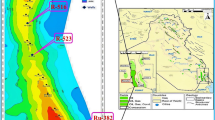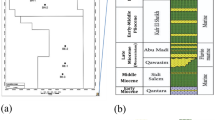Abstract
The evaluation of the Rumaila Oilfield in Southern Iraq, focusing on the characteristics and fluid behavior of the Zubair Formation of the Early Cretaceous age, includes applying petrophysical analysis, nuclear magnetic resonance (NMR) log, and modular formation dynamics tester (MDT). The integration of the NMR logging with conventional open hole logging provides valuable additional data for lithology and petrophysical parameters analysis in wells (R-516, R-523, and Ru-382). The study involves multifaceted techniques, including NMR T2 distributions, permeability, fluid saturation calculations, and porosity curves alongside CPI interpretations. MDT data offers direct measurements of pressure, mobility, and permeability. Permeability evaluations indicate good reservoir quality with porosity (13–23%) and permeability (45.97–157.32 md) values; the results showed that the main pay in the Zubair Formation can be divided into multiple reservoir zones (6 units) with different petrophysical characteristics. Accurate calculations of net pay, and net/gross ratio, and the logs interpretation detect the presence of movable hydrocarbons and irreducible water saturation across all studied reservoir units, except for units (H and MN) in R-523 and Ru-382, indicating that units have immovable hydrocarbons and free reservoir water. Fluid contacts in the Zubair reservoir units are identified using formation pressure tester data, CPI interpretations, and reservoir saturation data. The study confirms the high resolution of the NMR log, providing additional data while noting generally good borehole conditions, excluding intervals with washouts and shale layers, with a few NMR measurement effects. MDT tools are utilized for formation pressure gradient analysis related to liquid pressure in permeable formations. Pressure evaluation across main pay units is good in acquiring data, identifying fluids, and matching data with conventional logs. Integrating these three data types enables a comprehensive understanding of the main pay in the Zubair Formation; this method can give a better understanding of reservoir characterization, fluid typing, estimation of reservoir properties, and decision-making in oil and gas development operations.

















Similar content being viewed by others
Data availability
The data supporting this study’s findings are available from the corresponding author upon reasonable request.
References
Abudeif AM, Attia MM, Al-Khashab HM, Radwan AE (2018) Hydrocarbon type detection using the synthetic logs: a case study, Baba Member, Gulf of Suez, Egypt. J African Earth Sci 144:176–182. https://doi.org/10.1016/j.jafrearsci.2018.04.017
Al-Asadi Y (2021) 4D geomechanical modelling for Rumaila stacked oil reservoirs with applications to field development planning. Dissertation, University of Basrah
Almalikee HS (2018) Mechanical earth model (1D) to optimize high angle wells design in Rumaila Oilfield, Southern Iraq. Dissertation, University of Basrah
Almutury WGh, Al-Asadi MM (2008) Tectonostratigraphic history of Mesopotamian passive margin during Mesozoic and Cenozoic, South Iraq. J Kirkuk Univ Sci Stud 3(1):31–50
Al-Sakini JA (1992) Summary of petroleum geology of Iraq and the Middle East: Kirkuk, Northern Oil Company Press, Iraq. in Arabic 179P
Aqrawi AAM, Goff JC, Horbury AD, Sadooni FN (2010) The petroleum geology of Iraq. Scientific Press Ltd., Beaconsfield, Bucks, UK. 424P
Archie GE (1942) The electrical resistivity log as an aid in determining some reservoir characteristics. Trans AIME 146(01):54–62. https://doi.org/10.2118/942054-G
Asquith GB, Krygowski D, (with sections by Steven Henderson and Neil Hurley) (2004) Basic well log analysis. 2nd Edition. Volume 16. AAPG. Tulsa, Oklahoma. https://doi.org/10.1306/Mth16823
Bradley HB (1987) Petroleum engineering handbook: Richardson, TX. Society of Petroleum Engineers. 600P
Cannon S (2015) Petrophysics: a practical guide; Chichester: John Wiley and Sons, Ltd. 224P
Coates G, Marschall D, Mardon M, Galford J (1997) A new characterization of bulk-volume irreducible using magnetic resonance, paper presented at the SPWLA 38th Annual Logging Symposium, Houston, Texas, pp. 9–16. SPWLA-1997-QQ
Coates GR, Xiao L, Prammer MG (1999) NMR logging: principles and applications; Haliburton Energy Services. Houston iii. 234P
Conrad KM (1962) Application of the wireline formation tester. In Proceedings of the Drilling and Production Practices Conference, Beaumont, Texas, SPE-356-MS. https://doi.org/10.2118/356-MS
Dunn K-J, Bergman DJ, LaTorraca GA (2002) Nuclear magnetic resonance: petrophysical and logging applications, 1st ed. Elsevier, New York: Handbook of Geophysical Exploration: Seismic Exploration, Pergamon Press 32
Freedman R, Minh CC, Gubelin G, Freeman JJ, McGinness T, Terry B, Rawlence D (1998) Combining NMR and density logs for petrophysical analysis in gas-bearing formations. In Proceedings of the SPWLA 39th Annual Logging Symposium. https://doi.org/10.1306/00AA86DE-1730-11D7-8645000102C1865D
Galford JE, Marschall DM (2000) Combining NMR and conventional logs to determine fluid volumes and oil viscosity in heavy-oil reservoirs. In Proceedings of the SPE Annual Technical Conference and Exhibition, Dallas, Texas. https://doi.org/10.2118/63257-MS
Jawad Sh M (2018) Identification of heavy oil (Tar Mats) deposits, their distribution and forming mechanism in the main pay of the Zubair Formation in North Rumaila Oil Field, Southern Iraq. Dissertation, University of Basrah
Liu H (2017) Principles and applications of well logging. 2nd Edition. Springer Berlin, Heidelberg. 356P. https://doi.org/10.1007/978-3-662-54977-3
Minh CC, Gubelin G, Ramamoorthy R, McGeoch S (1999) Sonic-magnetic resonance method: a source less porosity evaluation in gas-bearing reservoirs. In Proceedings of the SPE Annual Technical Conference and Exhibition, Houston, Texas.https://doi.org/10.2118/56767-MS
Nolen-Hoeksema R (2014) Defining and determining permeability. Oilfield Review 26(3)
Poupon A, Leveaux J, (1971) Evaluation of water saturation in Shaly Formations. The Log Analyst 12 (04). SPWLA-1971-vXIIn4a1
Ramamoorthy R, Boyd A, Neville TJ, Seleznev N, Flaum C, Ma J (2010) A new workflow for petrophysical and textural evaluation of carbonate reservoirs. In Proceedings of the SPWLA 49th Annual Logging Symposium. OnePetro. Petrophysics 51:17–31
ROO, Rumaila Operating Organization (2016) Integrated subsurface description. Unpublished report, 140P
Rumaila.iq. (2018) A rare super-giant field. Rumaila Operating Organization. URL www.rumaila.iq/english/the-oilfield.php.
Sadooni FN, Aqrawi AAM (2000) Cretaceous sequence stratigraphy and petroleum potential of the Mesopotamian Basin, Iraq, Middle East Models of Jurassic/Cretaceous Carbonate Systems, SEPM Society for Sedimentary Geology, pp 315–334. https://doi.org/10.2110/pec.00.69.0315
Schlumberger (1972) Schlumberger log interpretation: principles, 1st ed. Schlumberger Limited, Houston
Schlumberger (1997) Cased-hole log interpretation principles/applications, 4th ed. 203P
Sharland PR, Archer R, Casey DM, Davies RB, Hall SH, Heward AP, Horbury AD, Simmons MD (2001) Arabian plate sequence stratigraphy. GeoArabia, GeoArabia Special Publication, Bahrain Gulf PetroLink. 2(374)
Worthington PF (1985) The evolution of shaly-sand concepts in reservoir evaluation. The Log Analyst 26 (01). SPWLA-1985-vXXVIn1a2
Worthington PF, Hattingh SKF (2014) Optimizing the value of reservoir simulation through quality-assured initialization. Pet Geosci 20(3):283–301. https://doi.org/10.1144/petgeo2013-012
Zdravkov BD, Čermák JJ, Šefara M, Janků J (2007) Pore classification in the characterization of porous materials: a perspective. Cent Eur J Chem 5:385–395. https://doi.org/10.2478/s11532-007-0017-9
Author information
Authors and Affiliations
Corresponding author
Ethics declarations
Conflict of interest
The authors want to declare that they do not have any conflict of interest to disclose or personal relationships that could have appeared to influence the work reported in this paper.
Additional information
Responsible Editor: François Roure
Supplementary Information
Below is the link to the electronic supplementary material.
Rights and permissions
Springer Nature or its licensor (e.g. a society or other partner) holds exclusive rights to this article under a publishing agreement with the author(s) or other rightsholder(s); author self-archiving of the accepted manuscript version of this article is solely governed by the terms of such publishing agreement and applicable law.
About this article
Cite this article
Chafeet, H.A., Handhal, A.M. Petrophysical, NMR, and MDT analysis to evaluate the Zubair formation in the Rumaila Oilfield, Southern Iraq. Arab J Geosci 17, 127 (2024). https://doi.org/10.1007/s12517-024-11936-1
Received:
Accepted:
Published:
DOI: https://doi.org/10.1007/s12517-024-11936-1




